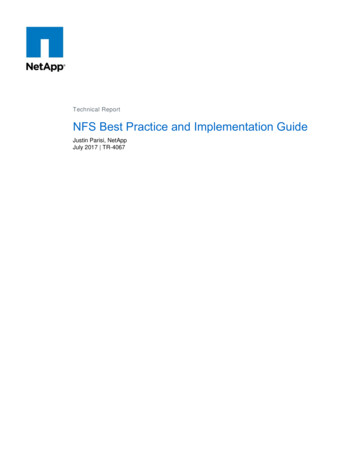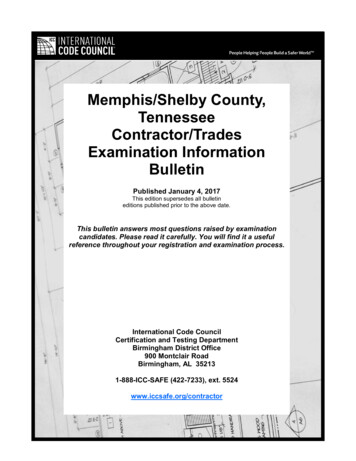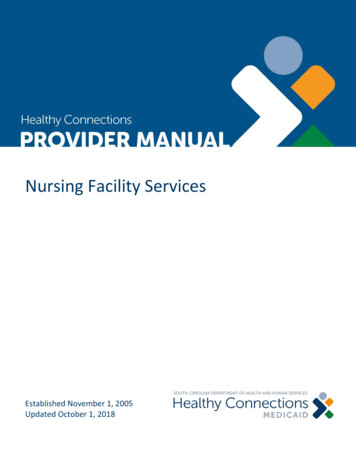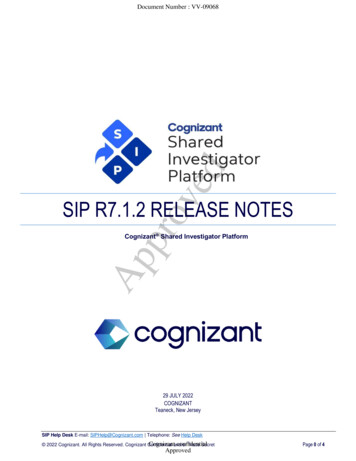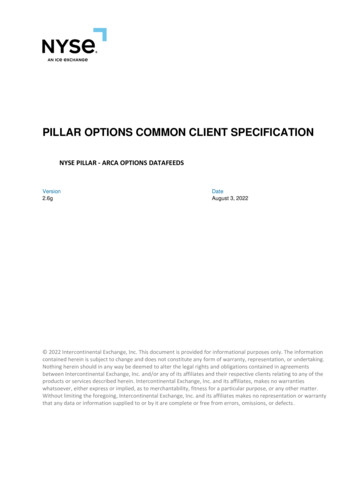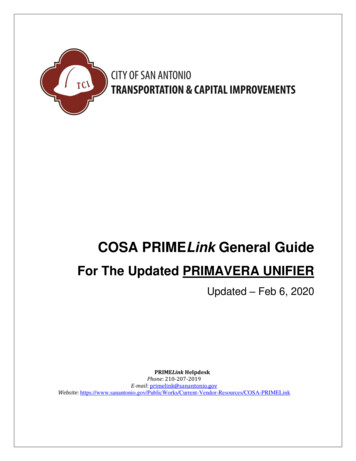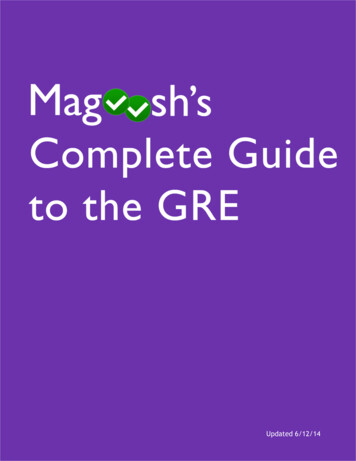
Transcription
Updated 6/12/14
1Table of ContentsTable of Contents . 1Introduction. 3The Magoosh Team . 3About Us . 4What is Magoosh? . 4Featured in . 4Why Our Students Love Us . 5Meet the Revised GRE . 7Breakdown . 7How is the Revised GRE Scored?. 9Adaptive Nature . 10The Quantitative Section . 12Question Types: Multiple Choice . 12Question Types: Multiple Answer Questions (MAQs) . 13Question Types: Numeric Entry . 15Question Types: Quantitative Comparison . 16Pacing Strategies . 18Calculator Strategies. 20Math Formula Cheat Sheet . 24Basic Concepts: Algebra . 27Basic Concepts: Combinations and “Permutations” . 29Basic Concepts: Probability . 36Basic Concepts: Factorials . 41Basic Concepts: Data Interpretation . 42Practice Questions . 47Verbal Section . 51Question Types: Text Completions . 51Question Types: Sentence Equivalence . 53Suggestions for this eBook?Leave us a comment here: .com/
2Question Types: Reading Comprehension . 55Question Types: Argument Questions (Critical Reasoning) . 57Pacing Strategies . 59Vocabulary: Learning in Context . 61Vocabulary: Magazines and Newspapers . 63Practice Questions . 67Analytical Writing Assessment . 72The Argument Essay . 74The Issue Essay . 76Resources . 78Study Plans . 78Official Practice Material from ETS . 79Book Reviews . 82Suggestions for this eBook?Leave us a comment here: .com/
3IntroductionThis eBook is meant to serve as an introduction to the revised GRE and combines information fromsome of the most popular posts on the Magoosh GRE blog. If you’re new to the GRE, and want toknow what to expect and how to prepare, this eBook is for you!If you’re already familiar with the exam and are looking for in-depth study material, head over tothe Resources section.The Magoosh TeamE-mail us at support@magoosh.com if you have any questions, comments, or suggestions!Suggestions for this eBook?Leave us a comment here: .com/
4About UsWhat is Magoosh?Magoosh is online GRE Prep that offers: Over 200 Math, Verbal, and AWA lesson videos. That’s over 20 hours of video!Over 1000 Math and Verbal practice questions, with video explanations after every questionMaterial created by expert tutors who have in-depth knowledge of the GREE-mail support from our expert tutorsCustomizable practice sessions and mock testsPersonalized statistics based on performanceAccess anytime, anywhere from an internet-connected deviceFeatured inSuggestions for this eBook?Leave us a comment here: .com/
5Why Our Students Love UsThese are survey responses sent to us by students after they took the GRE. All of these studentsand thousands more have used the Magoosh GRE prep course to improve their scores:Suggestions for this eBook?Leave us a comment here: .com/
6Suggestions for this eBook?Leave us a comment here: .com/
7Meet the Revised GREBreakdownThe SectionsThe Revised GRE will consist of two Verbal sections, two Quantitative sections, and oneexperimental section, which can be either Verbal or Quant. The experimental section will notcount towards your score. You will receive an overall Quantitative score in the 130 to 170 range,and an overall Verbal score, also from 130 to 170. Thus, the Revised GRE is out of 340.Number of questions and time limitFor the computer-based exam, the Verbal sections contain 20 questions each. You will be given 30minutes to complete each section. The Quantitative sections also consist of 20 questions each, butyou will have 35 minutes to complete each section.The Quantitative SectionsThe Quantitative section is made up of about 7 Quantitative Comparison Questions and 13 nonQuantitative Comparison questions (a majority of which will be Multiple Choice, with a few (1-2)Numeric Entry and Multiple Answer questions each).Multiple Choice is pretty standard—you’ll just have to identify the one possible correct answer.Multiple Answer can have up to 10 answer choices, and you’ll have to “select all that apply”, whichmeans that the number of correct answers is also unknown.Numeric Entry is an open-ended question type in which you will have to type in the correct value.Quantitative Comparison will list two quantities, A and B (anything from algebraic expressions tothe side length of a given geometric shape) and ask you to compare them and select one of thefollowing: A is equal to B, A is greater than B, A is less than B, or that the relationship between thetwo quantities cannot be determined from the information given.Additionally, there is a basic on-screen calculator that you will have access to during theQuantitative sections.Suggestions for this eBook?Leave us a comment here: .com/
8The Verbal SectionsThe Verbal Section is made up of about 6 Text Completions, 4 Sentence Equivalence questions, and10 Reading Comprehension questions.Text Completions can have one to three blanks, and range from short sentences to a four-sentenceparagraphs. For two- and three-blank Text Completion questions, you must answer each blankcorrectly to receive full points—no partial credit!Sentence Equivalence questions have six possible answer choices. For every Sentence Equivalencequestion, there will be two correct answers. To receive any credit you must choose both correctanswers.Reading Comprehension passages range from 12 to 60 lines. Topic matter is usually academic innature and covers areas such as science, literature, and the social sciences. Question types includestandard multiple-choice questions, highlight the passage questions, and multiple-answerquestions, which require you to choose any one of three possible answer choices.The Writing SectionTo begin the test, there are two essays, and you’ll be given 30 minutes for each: The Issue and TheArgument. Neither is part of your 130 – 170 score. Each essay receives a score ranging from 0 – 6.Your final essay score is the average of both essay scores.We have in-depth examples and strategies for each section later in this book.Suggestions for this eBook?Leave us a comment here: .com/
9How is the Revised GRE Scored?The Revised GRE scale may seem pretty arbitrary. After all, who has ever been graded on a testfrom 130 – 170? Not that the 200 – 800 scale was standard, but, still, there was a certain panache inbeing able to say, “I got an 800!” (a 170 sounds far from perfect). And, just to clarify, both thesescales apply to the verbal section and math section, so, technically, the new GRE is out of 340(which sounds just as awkward).So, why the strange range (pardon the rhyme)? Well, according to ETS, they wanted to stick tothree digits so that the colleges wouldn’t have to overhaul all the textbox entries that call forthree digits. Fair enough. Also, to avoid confusion with the current scoring system, ETS made surethe two score ranges didn’t overlap (had they made the new GRE out of 200, then a person who’dgotten that score on the current GRE would suddenly look a lot smarter if they were to say a fewyears from now, “Hey, I got a 200 on the GRE verbal section”).On the surface, the new GRE scoring range appears to be more limited than that of the currentsystem. After all, 200 – 800, based on 10-point intervals, allows for only a 61-point spread,compared to the new GRE’s 41-point spread, based on one-point intervals. The new GRE makes upfor this more limited range by giving more significance to the extreme ends of the scale. Forexample, on the current GRE, there really isn’t much difference between 730 and 800 on theverbal—they are both in the 99th percentile range. On the new GRE, the difference between 165and 170 will be the 99th percentile vs. the 96th percentile.At the end of the day, you are not going to be tested on these statistical nuances. The importantthing to remember is that many colleges base their rankings on a percentile score, which you willalso receive as part of your score report.Suggestions for this eBook?Leave us a comment here: .com/
10Adaptive NatureOn the old GRE, the test adapted within each section. The computer would assume that every testtaker was equal and would typically start with a mid-range question. If the test taker answered afew questions correctly, the test would become progressively difficult. And if the test takeranswered the questions incorrectly, the test would become progressively easier.The old GRE algorithm is slightly more nuanced than this, but really the details, at this point, aremoot. We only care about the Revised GRE.The Revised GRE adapts between sectionsA salient difference between the old GRE and Revised GRE is that the Revised GRE has two sectionsfor Math and two sections for Verbal. The old GRE had one section for each. That the Revised GREhas two sections for each subject is significant—this allows ETS to make the test adapt betweensections.There is no adaptation within sectionThe section adaptation is the only adaptation that happens on the Revised GRE. What this means isthat the questions do not change depending on whether you answer them correctly. Think of it thisway – each section is static. Your performance on the first section will determine whether you getan easy section or a difficult section. The easy section is static and the difficult section is static.Again, this means the questions in the section do not change. You could miss the first ten andquestion 11 will still be question 11; you could work backwards from the last question, nailing all ofthem, and question 11 is still question 11.The level of difficulty of questions is randomEven though a section is static it doesn’t mean that, theoretically, it couldn’t become progressivelyharder. After all, this is what the old old GRE (meaning the paper-based 1990 GRE) was like.However, there is no order of difficulty on the Revised GRE. The first question can be the hardestand the last question the easiest.Each question is weighted the sameDo not spend 5 minutes trying to answer the question in which four circles are wedged inside someoctagon (actually, that would make an interesting question – but another time!). Each question isbasically weighed the same. So the question that gives you the radius and asks for the area, whichshould take no more than 15 seconds, is worth the same as the one about the monstrous polygon.Suggestions for this eBook?Leave us a comment here: .com/
11Can you let up at the end?Again, each question is weighted the same – and the computer hasn’t “figured you out” the way itsupposedly did with the old GRE. Your score on the Revised GRE is based on how many questionsyou miss. The point here is that you do not reach a certain level in which the computer “thinks”you are doing very well (à la the old GRE). So do not slack off at the end, thinking you answeredmost questions correctly and now you’re set.The only reason I even mention this – as it is counterintuitive – is because many are still operatingunder the conception of the old GRE, in which you could, at least somewhat, slack off at the endwithout hurting your score too much.Takeaways The Revised GRE does not adapt within a section, only between sectionsEach question is weighted the sameDifficult questions and easy questions are randomly mixed throughout the sectionSuggestions for this eBook?Leave us a comment here: .com/
12The Quantitative SectionQuestion Types: Multiple ChoiceJust a regular multiple choice question, with only one right answer! Here’s an example—try it outfor yourself before checking the explanation below.Which of the following equations is true for all positive values of x and y?Answer and Explanation:You can try this question online and watch the explanation video ons for this eBook?Leave us a comment here: .com/
13Question Types: Multiple Answer Questions (MAQs)The new GRE is officially calling these Multiple Choice Questions: Select One or More Answers. Forbrevity—and clarity’s sake—I’m going to call them MAQs: Multiple Answer Questions.Doesn’t sound too complicated? Well, I could ask you to imagine a question that has ten possibleanswer choices, any number of which could be correct. Or, I could just ask you to turn to page 123of the ETS Revised GRE book, for those of you who’ve already picked up a copy.Those well-versed in their combinations/permutations problem know the chances of guessingcorrectly on this question is 1 in 1,023, odds so slim the question might as well have been a bigempty fill-in the blank (yeah, the Math section has those too).I’m probably making the Quantitative MAQ’s sound scarier than they actually are. Most willprobably only have five or six possible answer choices, not ten. The bottom line: if you know theconcept being tested, and are careful and methodical, then you should be able to get thiscumbersome question type correct.Here is an example of an MAQ that I think you should definitely be capable of getting right if you’recareful:If n is a two-digit number, in which n xy. If x y 8, and x and y are positive integersgreater than 1, then the units digit of n could be which of the following?A.B.C.D.E.F.G.H.I.J.0123456789As a side note, on the actual Revised GRE, each answer choice will have a square around it. Whenyou see the square you know you’re dealing with Multiple Answer Questions. If there is a circlearound the answer choice, then it is business as usual—one answer only.As for the question above, the answers are B, C, E, F, G, and H.If you missed the question, remember that x y has to be less than 8. Also, make sure you writesomething down when tackling Multiple Answer Questions. Trying to juggle all the information inyour head will surely get you in trouble.Suggestions for this eBook?Leave us a comment here: .com/
14Suggestions for this eBook?Leave us a comment here: .com/
15Question Types: Numeric EntryTwo trains starting from cities 300 miles apart head in opposite directions at rates of 70 mphand 50 mph, respectively. How long does it take the trains to cross paths?This is a classic problem that sends chills up students’ spines. I’m now going to add another bonerattling element: The Empty Box.That’s right—the GRE will have fill-in-the blank/empty box math problems, called Numeric Entry.There won’t be too many, judging from the ETS Revised GRE book, but even a few should beenough to discomfit most.Let’s go back and attack the above problem the following way. When you have any two entities(trains, bicyclists, cars, etc.) headed towards each other you must add their rates to find thecombined rate. The logic behind the combined rate is the two trains (as is the case here) arecoming from opposite directions, straight into each other.This yields 120 mph, a very fast rate (which accounts for the severity of head-on collisions don’tworry, the trains in the problem won’t collide!).To find the final answer, we want to employ our nifty old formula: D RT, where D stands fordistance, R stands for rate, and T stands for time.We’ve already found R, which is their combined rate of 120 mph. They are 300 miles apart so thatis D. Plugging those values in, we get 300 120T. Dividing 120 by both sides, we get T 2.5 hrs.Now we can confidently fill that box in, and let the trains continue on their respective ways.Suggestions for this eBook?Leave us a comment here: .com/
16Question Types: Quantitative ComparisonQuantitative Comparison (QC) is a huge part of the GRE, roughly one-third of the Quant section.Often, when prepping, you may forget this fact and spend much more time on problem solving.Quantitative Comparison is a unique beast—while the math concepts are the exact same as thosecovered in Problem Solving, QC can be very tricky. In fact, the test writers work very hard to makethese questions seem very straightforward. Yet, there is usually a trap or twist, waiting to ensnarethe unsuspecting test taker.The format will always be the same: comparing two quantities (Column A vs. Column B), with thesame 4 answer choices that evaluate the relationship between the two quantities. However, thequantities for Column A and B can be anything from expressions with variables to references to aquantity in a geometric shape.Column AThe number of positivemultiples of 49 less than 2000TheTheTheTheColumn BThe number of positive multiples of50 less than or equal to 2000quantity in Column A is greaterquantity in Column B is greatertwo quantities are equalrelationship cannot be determined from the information givenThe ApproachFirst off, we must understand what a multiple is. A multiple is any number that results whenmultiplying an integer, x, by 1, 2, 3, 4 If x is equal to 5, then the multiples of 5 would be:5x1 55 x 2 105 x 3 155 x 4 205 x 5 255 x 6 30 Suggestions for this eBook?Leave us a comment here: .com/
17From the table above, we can see that any multiple of 5 is divisible by 5. For instance, 1000/5 200. Therefore, 1000 is a multiple of 5.The question above asks us how many multiples of 49 are less than 2000. We can divide 2000 by 49to see how many multiples of 49 are less than 2000. Doing so may take a while. A faster way is tonote that 49 is very close to 50. Quick math allows us to determine that 50 x 40 is 2000. Therefore,49 x 40 equals 40 less than 2000, or 1960. If we were to multiply 49 x 41, we are adding 1960 49,which takes us to 2009. This is greater than 2000. Therefore, we know that there are only 40multiples of 49 less than 2000.What about column B? Well, we’ve already figured out that 40 x 50 equals 2000. But, here is thetricky part. Whereas Column A stipulated that the number has to be less than 2000, Column B saysthe number has to be less than OR equal to 2000. Therefore, there are 40 multiples of 50 that areless than or equal to 2000. (I wrote this question, and I know it is evil. But sneakily adding a coupleof words that changes the answer is a classic trick employed by the writers of the test).Answer: C.First InstinctsThere is a good chance that your first instinct was A. Clearly, 49 is lower than 50, so it has to havemore multiples. Usually, when the answer to a Quantitative Comparison question appearsobvious at first glance, there is some twist to the problem. In this case, the twist was the wordingin Column B: less than or equal to 2000. So, be wary of any QC questions that seem too easy. Lookfor a twist or a trap.Suggestions for this eBook?Leave us a comment here: .com/
18Pacing StrategiesEach math section contains 20 questions. You are given 35 minutes for each section, which worksout to 1:45 seconds per question. Below are some helpful tips to help you wisely use these 35minutes.Go for the low hanging fruitEach question in the GRE quantitative section is worth the same number of points. That is such animportant point that I am going to repeat it again (in caps): EACH QUESTION ON THE GRE SECTIONIS WORTH THE SAME NUMBER OF POINTS.That’s right, folks. If ETS devised a question such as the following:The five minutes you’d take to (maybe) answer the question correctly will yield the exact samenumber of points as this question:If, what is the value of x?So what’s the takeaway from this? Other than, “Factorials scare the living expletive out of me!”?Well, why waste time on a very difficult question when you can simply scroll to an easier question?Think of it this way: in 35 minutes you want to score as many points as you can, and each questionis worth the same.If I paid you 1,000 dollars for every apple you picked from a tree in 35 minutes, what would you do?You would go for the low hanging fruit. You would not waste your time climbing to the very top ofthe tree to pluck an apple that is worth the same amount of money as an apple that you can simplyreach out and grab with both your feet planted on the ground.Of course, after a certain point—that is to get a high score—you must grab the fruit up on high, andgo for the difficult questions. But make sure you’ve answered the easy ones first.How much time should I budget per question?The answer differs depending on how difficult the question is. Think of it this way. There are easyquestions, medium questions, and difficult questions. Easy questions should take between 45seconds and 1 minute. Medium questions should take between 1:00 – 2:00. And difficult questionsSuggestions for this eBook?Leave us a comment here: .com/
19should take no longer than 3 minutes. The ratio of easy, medium, and difficult questions vary persection but in general you can expect to see a smattering of each. On the easy section, the ratiowill skew towards easy; in the difficult section that ratio will skew towards difficult.Learning to let a question goIf you are staring at a question and have been unable to devise a solution after a minute, youshould seriously consider moving on to the next question. Again, keep the low-hanging fruitmetaphor in mind.If, however, you are dealing with a difficult math question (and it is clear that it is difficult, andyou’re not just missing something obvious), then take a couple of minutes, as some questions willclearly take that much time. Do not freak out on a question that is clearly convoluted just becauseyou’ve taken 2 minutes. As long as you are headed toward the solution, persevere.Do not be sloppy but do not obsess over easy questionsUsing the time schematic above, we can see that easy questions can take less than a minute. It isimportant to answer these questions confidently and move on. If you dither, then that is time thatcould be spent on a more difficult question. However, do not race through an easy question,because then it defeats my whole low-hanging fruit sermon—missing a question that you couldeasily have answered correctly had you spent that extra second does not make sense (especially ifyou are racing towards difficult questions that you may not even answer correctly in the firstplace).Make sure you guessYou do not even have to approach every question, especially the difficult ones, as I mentionedabove. But make sure at the very end that you guess on any questions remaining, because there isno penalty for guessing. So if you’ve been skipping a lot of questions, give yourself enough time atthe end to bubble in the questions you left blank. A little bit of luck can go a long way!Suggestions for this eBook?Leave us a comment here: .com/
20Calculator StrategiesFor many students, the addition of the GRE’s onscreen calculator to the new exam is a godsend.These students take solace in the notion that this new calculator will help them solve tons ofquestions. The truth of the matter is that almost all math questions on the Revised GRE can besolved without a calculator. Furthermore, in many cases, it will actually take longer to solve aquestion using a calculator that it will to use other techniques. Finally, the test-makers are takingquestions that can be easily solved with a calculator and changing the numbers in order to renderthe calculator useless.For example, a former GRE question would have asked you to evaluate–. The slowsolution was to perform the actual (tedious) calculations. The fast solution was to recognize thatthis difference of squares can be factored aswhich equals, which equals,.Since this question would be too easy to solve using the onscreen calculator, the test-makers willchange the question towhereandhave too many digits for thecalculator to handle. As such, you’ll have to solve this question using factoring techniques.Aside: the onscreen calculator displays up to eight digits. If a computation results in a numbergreater than9-digit number.then an ERROR message is displayed. When you evaluateyou get aNow, despite the test-makers’ attempts to remove the calculator from your arsenal, thereare times when you can make a few adjustments to a question and then quickly answer it with thecalculator.We can solve the following question using a variety of techniques and strategies:Column ATheTheTheTheColumn Bquantity in Column A is greaterquantity in Column B is greatertwo quantities are equalrelationship cannot be determined from the information givenNotice that these numbers yield products that are too big for the calculator to handle. However,with a few adjustments we can use a new strategy with the calculator to answer the question.Suggestions for this eBook?Leave us a comment here: .com/
21One solution is to first divide each column by 1,000,000. When we do this, we get:Column AColumn BFrom here, we can rewrite this as:Column AColumn BAnd this is the same as:Column AColumn BAt this point, we can use the calculator enter all of these values, and each resulting product willhave fewer than 8 digits.So, with a small modification, we can answer this question using a calculator.Now, can you think of another approach that allows you to use a calculator to solve the originalquestion (without dividing by 1,000,000 or any other powers of 10)?Here’s the original question:Column AColumn BAnother approach is to first divide both sides by 641,713 to get:Column AColumn BSuggestions for this eBook?Leave us a comment here: .com/
22Then, divide both sides by 897,189 to get:Column AColumn BAt this point, we can enter all of these values into the calculator and compare the columns.Next, we’ll examine another strategy to thwart the Revised GRE and use the onscreen calculator tosolve questions that, at first glance, appear to render the calculator useless:The square root of 2 billion is between2,000 and 5,0005,000 and 15,00015,000 and 30,00030,000 and 50,00050,000 and 90,000Try to identify at least two ways
and thousands more have used the Magoosh GRE prep course to improve their scores: 6 . A salient difference between the old GRE and Revised GRE is that the Revised GRE has two sections for Math and two sections for Verbal. The old GRE had one section for each. That the Revised GRE

